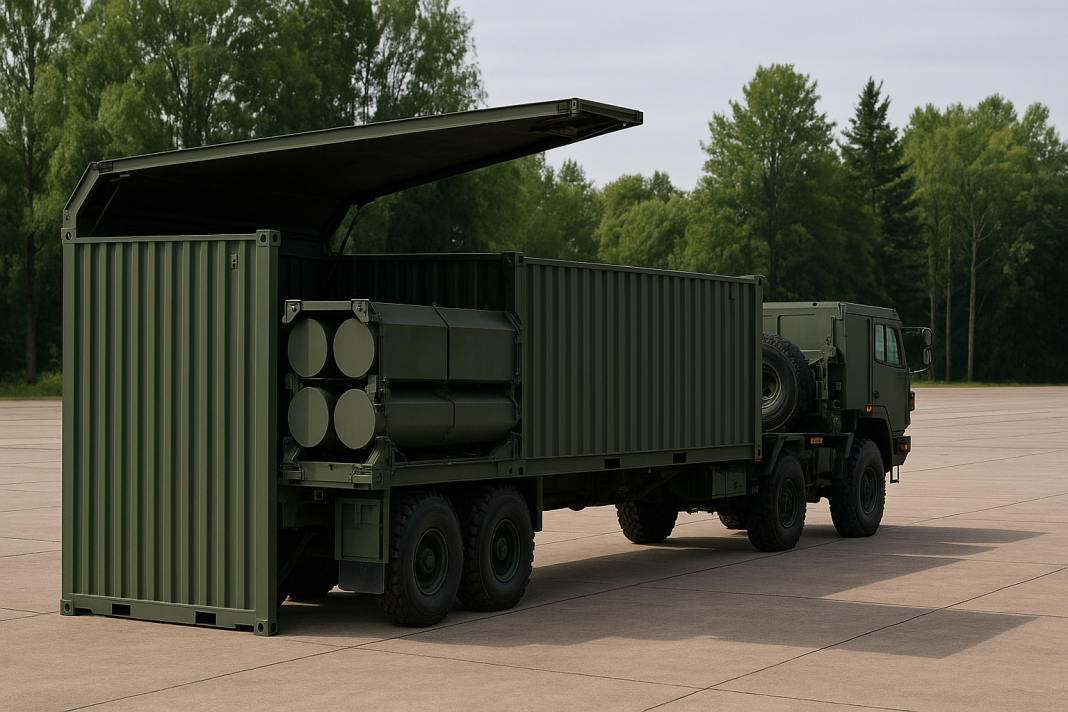China’s military has raised serious concerns over a newly revealed containerised launcher system developed by the United States. This launcher system is different because it is designed to be hidden inside a regular shipping container.
US Reveals Containerised Launcher Hidden in Shipping Containers
The containerised launcher was spotted during a recent video from the US Army’s Fort Bragg base in North Carolina.
According to a report published in PLA Daily, the official newspaper of China’s military, this system poses a significant threat to the security of the Asia-Pacific region. The launcher can reportedly fire multiple types of missiles, including those used in the M270 Multiple Launch Rocket System (MLRS) and the M142 High Mobility Artillery Rocket System (HIMARS).
This containerised launcher does not rely on any specific base or vehicle. Instead, the US military can load it onto any truck that carries a standard shipping container. They can then transport the container and use it to launch missiles secretly, avoiding detection. Since it looks like a regular civilian shipping container, identifying or tracking it becomes extremely difficult.
U.S. Army unveils AI-powered missile launchers that can fire, reload, and move without soldiers
The PLA Daily commentary highlighted that the US military displayed this containerised launcher during the President’s June visit to Fort Bragg. The container’s roof opened partially, revealing two missile launcher tubes similar to those used in the HIMARS and MLRS systems.
High Concealment of Containerised Launcher Sparks Alarm
One of the main concerns China’s military raised is how well this launcher system hides. Since it looks like a regular shipping container, operators can easily mix it in with everyday cargo. They can paint the system to match civilian colors and transport it by sea or land without drawing attention.
This method makes the containerised launcher hard to detect, giving the US military the advantage of surprise. It allows for sudden attacks from multiple places at once, without warning. According to the PLA commentary, this high level of concealment increases the survivability of the missile system and makes it possible to deploy it almost anywhere in the world.
US Military Watch: More Spy Planes Deployed to Track China, Russia, North Korea
The Chinese military compared this idea to a recent Ukrainian operation called “Operation Spiderweb.” In that mission, Ukrainian forces hid drones inside modified containers and secretly moved them into Russia. They later used these drones to strike high-value targets, showing how effective container-based weapons can be.
The PLA article warned that the US could move the containerised launcher to a launch site in secret and use it without triggering early detection. This level of stealth raises serious concerns in high-tension areas, such as the South China Sea or near Taiwan.
The US has also developed a similar system known as the Mk70 containerised vertical launch system. It can launch various missiles, including Standard air defense missiles and long-range Tomahawk missiles, which can reach targets up to 1,600 kilometers away.
Deployment in Asia Raises Red Flags
The PLA commentary mentioned that one of the US Army’s containerised systems, known as Typhon, was already deployed in 2024 to Luzon Island in the Philippines. From that location, missiles could reach a wide range of targets, including the entire South China Sea and Taiwan.
The Typhon system is a land-based missile launcher that uses the same containerised launcher concept. It gives the US Army more flexibility in moving and firing missiles across the region.
Other countries in the region are also showing interest in this technology. The Philippines has announced its intention to purchase more Typhon systems to improve its defense. Japan has also begun exploring the development of a similar system, focusing on containerised launchers for long-range anti-ship missiles.
🌍 Pentagon powers Bulgaria — missile deal marks geostrategic shift in European defense map
These developments have added to the Chinese military’s concern. The PLA Daily commentary stated that such systems, although described by the US as simple upgrades, are actually preparations for high-level military action. They believe these systems could destabilize the region and lead to misunderstandings or unexpected conflicts.
The article ended by warning that the growing use of containerised launcher technology by the US and its allies should be taken seriously by regional countries and the international community. According to the commentary, this trend could have serious consequences for peace and security in the Asia-Pacific.

